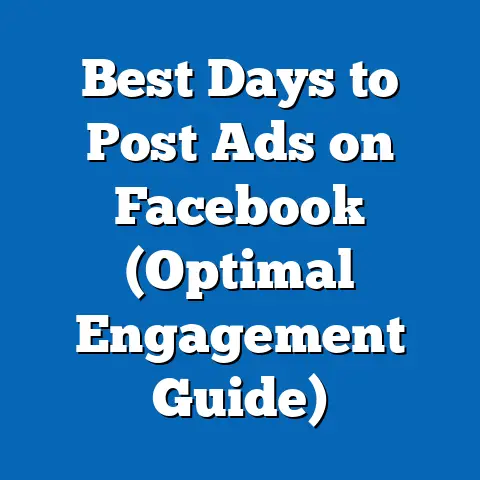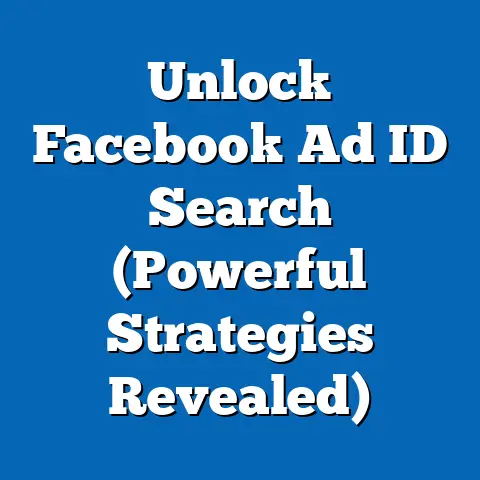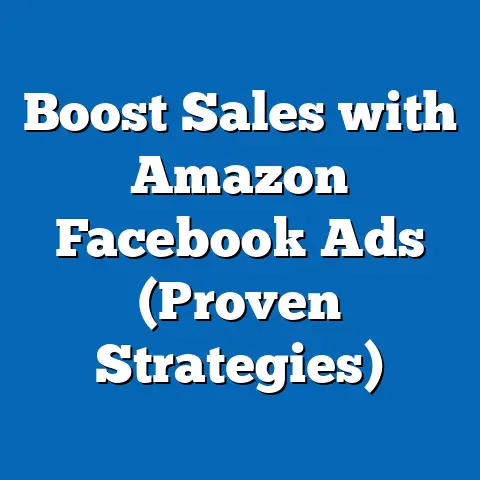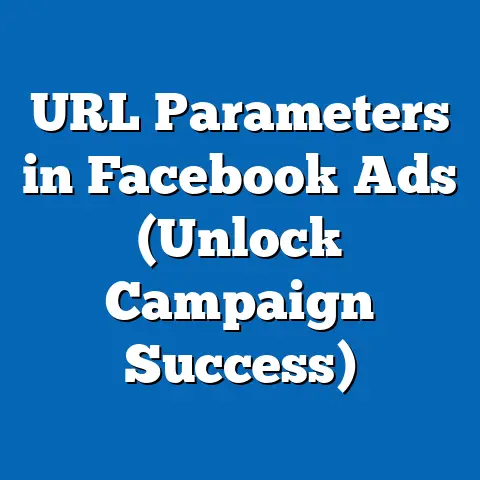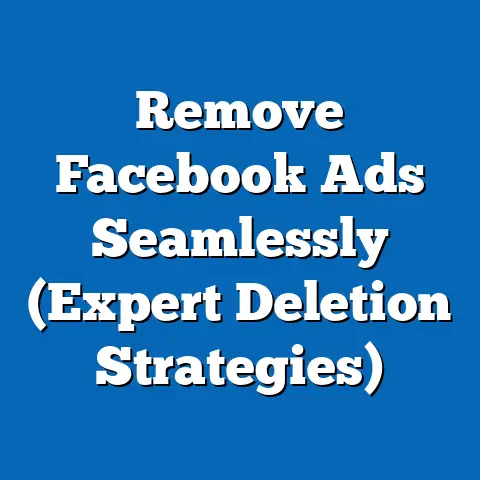Master Low CPC Facebook Ads (Proven Strategies Inside)
Facebook advertising is an art. It’s not just about throwing money at ads and hoping something sticks. It’s about crafting the perfect message, targeting the right audience, and constantly refining your approach to get the most bang for your buck. Lowering your Cost-Per-Click (CPC) is a key part of this art, and it requires a blend of creativity, data-driven strategies, and a deep understanding of the Facebook platform.
I’ve spent years navigating the world of Facebook ads, and I can tell you from personal experience that mastering low CPC is a game-changer. It allows you to reach more people, generate more leads, and ultimately, grow your business without breaking the bank. In this guide, I’m going to share some proven strategies that I’ve used to consistently achieve low CPCs for my clients and myself. Consider this your personal playbook for turning your Facebook ad campaigns into cost-effective marketing powerhouses.
Understanding Facebook Ads and CPC
Before diving into the strategies, let’s make sure we’re all on the same page with the basics.
What is CPC?
CPC stands for Cost-Per-Click. It’s the amount you pay each time someone clicks on your Facebook ad. It’s a crucial metric because it directly impacts your advertising budget and how far your money goes. A lower CPC means you can get more clicks for the same amount of money, allowing you to reach a larger audience and potentially generate more leads or sales.
How Facebook’s Ad Auction Works
Facebook’s ad auction is a complex system that determines which ads are shown to users and how much advertisers pay for those ads. Several factors influence the outcome of the auction, including:
- Bid: The amount you’re willing to pay for a click or impression.
- Ad Relevance: How relevant your ad is to the target audience. Facebook assesses this based on user feedback, engagement rates, and other factors.
- Estimated Action Rates: Facebook’s prediction of how likely users are to take the desired action (e.g., click, purchase, download) after seeing your ad.
- Ad Quality: The overall quality of your ad, including its visual appeal, copy, and landing page experience.
The higher your bid, the more likely your ad is to be shown. However, simply bidding the highest amount doesn’t guarantee success. Facebook prioritizes ads that are relevant and engaging to users, even if they have lower bids.
The Relationship Between Ad Relevance, Quality Score, and CPC
This is where things get interesting. Facebook assigns a “relevance score” to your ads based on how well they resonate with your target audience. A high relevance score indicates that your ad is delivering a positive experience to users, which can lead to lower CPCs.
Similarly, Facebook also considers the overall quality of your ad. High-quality ads are visually appealing, well-written, and offer a clear value proposition. These ads tend to perform better and are rewarded with lower CPCs.
Think of it this way: Facebook wants to show ads that users will find interesting and useful. If your ad is relevant and high-quality, Facebook is more likely to show it to users, and you’ll pay less for each click.
Average CPC on Facebook (and How It Varies)
The average CPC on Facebook varies depending on several factors, including industry, target audience, ad placement, and campaign objective. According to recent data, the average CPC across all industries is around \$0.35 for link clicks. However, some industries, like finance and insurance, tend to have higher CPCs due to increased competition.
Here’s a quick breakdown of average CPCs by industry:
- Apparel: \$0.45
- Retail: \$0.70
- Finance: \$3.50
- Automotive: \$1.30
Keep in mind that these are just averages, and your actual CPC may be higher or lower depending on your specific campaign.
Takeaway: Understanding the mechanics of Facebook’s ad auction and the factors that influence CPC is essential for creating cost-effective campaigns. Focus on creating relevant, high-quality ads that resonate with your target audience to lower your CPC and maximize your ROI.
Targeting the Right Audience
One of the most significant factors influencing your CPC is your audience targeting. If you’re showing your ads to the wrong people, they’re less likely to click, and your CPC will skyrocket. Precision is key.
The Importance of Precise Audience Targeting
Think of it like this: if you’re selling vegan protein powder, you don’t want to show your ads to meat-eaters. You want to target people who are already interested in veganism, fitness, or healthy eating. By focusing your ads on the right audience, you’ll increase your chances of getting clicks from people who are genuinely interested in your product or service, which will lower your CPC.
Facebook’s Targeting Options
Facebook offers a wide range of targeting options to help you reach the right audience. These include:
- Demographics: Target users based on age, gender, location, education, job title, and other demographic factors.
- Interests: Target users based on their interests, hobbies, and passions. Facebook gathers this information from users’ page likes, group memberships, and other activities on the platform.
- Behaviors: Target users based on their online behavior, such as purchase history, device usage, and travel habits.
- Custom Audiences: Create custom audiences based on your existing customer data, such as email lists, website visitors, or app users. This allows you to retarget people who have already interacted with your business.
Creating Lookalike Audiences
Lookalike audiences are one of the most powerful targeting tools on Facebook. They allow you to reach new people who are similar to your existing customers. To create a lookalike audience, you simply upload your customer data to Facebook, and the platform will identify users who share similar characteristics.
For example, if you have a list of your top-spending customers, you can create a lookalike audience based on that list. Facebook will then target users who are similar to your top customers, increasing your chances of finding new high-value customers.
Retargeting Campaigns
Retargeting campaigns are another effective way to lower your CPC. Retargeting involves showing ads to people who have already interacted with your business, such as website visitors or app users. These people are already familiar with your brand, so they’re more likely to click on your ads.
For example, if someone visits your website but doesn’t make a purchase, you can retarget them with ads that promote the products they were viewing. This reminds them of your brand and encourages them to come back and complete the purchase.
Case Studies: Success Through Effective Targeting
I worked with a local bakery that was struggling to get traction with their Facebook ads. Their CPC was high, and they weren’t seeing a good return on their investment. After analyzing their target audience, I realized they were targeting too broad of an audience.
I helped them narrow their targeting to people who were interested in baking, desserts, and local businesses. I also created a custom audience based on their email list and website visitors. As a result, their CPC dropped by 50%, and they saw a significant increase in sales.
Takeaway: Precise audience targeting is crucial for lowering your CPC. Use Facebook’s targeting options to reach the right people, create lookalike audiences to find new customers, and retarget existing customers to drive conversions.
Crafting Compelling Ad Creatives
Your ad creative is the first thing people see, so it needs to grab their attention and make them want to click. A poorly designed ad can lead to low engagement and high CPCs, no matter how well you target your audience.
The Influence of Ad Creatives on CPC
Think of your ad creative as the storefront of your online business. If it’s cluttered, unappealing, or doesn’t clearly communicate your value proposition, people are going to walk right by. On the other hand, if it’s visually appealing, well-written, and offers a clear benefit, people will be more likely to stop and take a look.
Elements of High-Performing Ad Creatives
Here are some key elements of high-performing ad creatives:
- Visuals: Use high-quality images or videos that are relevant to your product or service. Make sure your visuals are eye-catching and grab the viewer’s attention.
- Copy: Write clear, concise copy that highlights the benefits of your product or service. Use strong calls to action that encourage people to click.
- Call-to-Action (CTA): Make sure your CTA is clear and compelling. Tell people exactly what you want them to do, whether it’s “Shop Now,” “Learn More,” or “Sign Up.”
A/B Testing Ad Formats
Facebook offers a variety of ad formats, including:
- Image Ads: Simple ads that feature a single image.
- Video Ads: Ads that feature a video.
- Carousel Ads: Ads that feature multiple images or videos in a carousel format.
- Slideshow Ads: Ads that combine multiple images into a slideshow.
The best way to determine which ad format works best for your business is to A/B test different options. A/B testing involves creating two versions of your ad with different formats and running them simultaneously to see which one performs better.
For example, you could A/B test an image ad against a video ad to see which one generates more clicks and lower CPCs.
Aligning Ad Creatives with Audience Preferences
It’s important to align your ad creatives with the preferences and behaviors of your target audience. For example, if you’re targeting millennials, you might want to use a more modern and visually appealing design. If you’re targeting baby boomers, you might want to use a more traditional and informative design.
I once worked with a clothing retailer that was struggling to connect with their target audience. Their ads were generic and didn’t resonate with the people they were trying to reach. After analyzing their target audience, I realized they were missing the mark.
I helped them create ads that featured real people wearing their clothes in everyday situations. I also used copy that spoke directly to their target audience’s pain points and aspirations. As a result, their CPC dropped dramatically, and they saw a significant increase in sales.
Takeaway: Crafting compelling ad creatives is essential for lowering your CPC. Use high-quality visuals, write clear and concise copy, and align your ad creatives with the preferences of your target audience. A/B test different ad formats to find the most cost-effective options.
Optimizing Ad Placement and Budgeting
Where your ad appears and how you manage your budget can significantly impact your CPC. Strategic placement and smart budgeting are crucial for maximizing your ROI.
Choosing the Right Ad Placements
Facebook offers a variety of ad placements, including:
- Facebook Feed: Ads that appear in users’ news feeds.
- Instagram Feed: Ads that appear in users’ Instagram feeds.
- Facebook Stories: Ads that appear in users’ Facebook Stories.
- Instagram Stories: Ads that appear in users’ Instagram Stories.
- Facebook Marketplace: Ads that appear in the Facebook Marketplace.
- Audience Network: Ads that appear on websites and apps outside of Facebook.
The best ad placement for your business will depend on your target audience and campaign objective. For example, if you’re trying to generate leads, you might want to focus on Facebook Feed and Instagram Feed placements. If you’re trying to drive brand awareness, you might want to focus on Facebook Stories and Instagram Stories placements.
Automatic Placements
Facebook’s automatic placements option allows the platform to automatically optimize your ad placements based on performance. This can be a good option if you’re not sure which placements to choose or if you want to save time and effort.
However, it’s important to monitor your performance closely when using automatic placements. If you notice that certain placements are performing poorly, you can exclude them from your campaign.
Budgeting Strategies
Facebook offers two main budgeting options:
- Daily Budget: The average amount you’re willing to spend each day on your ads.
- Lifetime Budget: The total amount you’re willing to spend on your ads over the course of the campaign.
The best budgeting option for your business will depend on your campaign goals and budget constraints. If you’re running a short-term campaign, you might want to use a lifetime budget. If you’re running a long-term campaign, you might want to use a daily budget.
Adjusting Bids for Better Performance
Facebook allows you to adjust your bids to control how much you’re willing to pay for each click or impression. You can adjust your bids manually or use Facebook’s automated bidding options.
Manual bidding allows you to set your bids based on your own analysis and judgment. Automated bidding allows Facebook to automatically adjust your bids based on performance.
Using Facebook’s Budget Optimization Tools
Facebook offers a variety of budget optimization tools to help you get the most out of your advertising budget. These tools include:
- Campaign Budget Optimization (CBO): Allows you to set a budget at the campaign level, and Facebook will automatically distribute the budget across your ad sets based on performance.
- Ad Set Budget Optimization (ABO): Allows you to set a budget at the ad set level, and Facebook will automatically optimize your bids within each ad set.
Takeaway: Optimizing your ad placement and budgeting is crucial for lowering your CPC. Choose the right ad placements for your target audience, use automatic placements to save time and effort, and adjust your bids for better performance.
Analyzing and Adjusting Campaigns
The work doesn’t stop after you launch your campaign. Regularly monitoring your ad performance and making adjustments based on the data is essential for maintaining low CPCs.
Monitoring Ad Performance Regularly
It’s important to monitor your ad performance regularly to identify trends and make adjustments as needed. This will help you optimize your campaigns for better results and lower CPCs.
Key Metrics to Track Beyond CPC
While CPC is an important metric, it’s not the only one you should be tracking. Other key metrics to track include:
- Click-Through Rate (CTR): The percentage of people who see your ad and click on it.
- Conversion Rate: The percentage of people who click on your ad and take the desired action (e.g., purchase, download, sign up).
- Return on Ad Spend (ROAS): The amount of revenue you generate for every dollar you spend on advertising.
Analyzing Ad Performance Data
To analyze your ad performance data, you can use Facebook Ads Manager. This tool provides a wealth of information about your campaigns, including:
- Impressions: The number of times your ad has been shown.
- Clicks: The number of times people have clicked on your ad.
- Reach: The number of unique people who have seen your ad.
- Frequency: The average number of times each person has seen your ad.
Making Informed Adjustments to Campaigns
Based on your analysis of your ad performance data, you can make informed adjustments to your campaigns to improve results and lower CPCs. These adjustments might include:
- Refining your targeting: If your ads aren’t reaching the right people, you might need to refine your targeting options.
- Updating your ad creatives: If your ads aren’t generating enough clicks, you might need to update your ad creatives.
- Adjusting your bids: If your CPC is too high, you might need to adjust your bids.
Takeaway: Monitoring your ad performance regularly and making informed adjustments based on the data is essential for maintaining low CPCs. Track key metrics beyond CPC, analyze your ad performance data, and make adjustments to your campaigns as needed.
Conclusion
Mastering low CPC Facebook ads is an ongoing journey. It requires a blend of creativity, analytics, and persistence. Embrace the strategies discussed in this guide, and continuously refine your approach to Facebook advertising. Remember that success lies in the balance of crafting compelling ads, targeting the right audience, and optimizing your campaigns based on data. The journey to mastering Facebook ads is a continuous learning process, filled with opportunities for growth and improvement. By embracing these strategies, you can transform your Facebook ad campaigns into cost-effective marketing tools that drive real results for your business.

